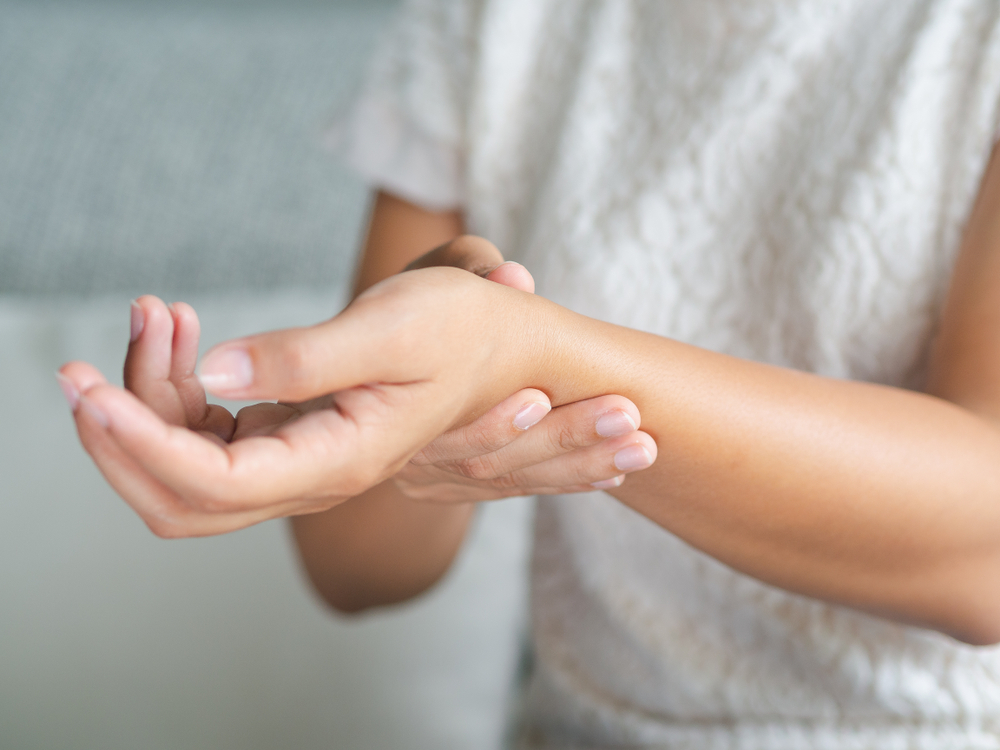
There are a plethora of well-known symptoms that present during pregnancy, but there is one lesser talked about one that many moms-to-be don’t realize is a possibility: carpal tunnel syndrome (CTS).
Here’s what to know about carpal tunnel syndrome (also named median nerve compression), what symptoms to look for, and how best to treat it.
What is Carpel Tunnel Syndrome and How Does It Present During Pregnancy?
The carpal tunnel is a narrow passageway in the wrist, about an inch wide. The floor and sides of the tunnel are formed by small wrist bones called carpal bones.
Carpal tunnel syndrome occurs when the tunnel becomes narrowed or when the tissue surrounding the flexor tendons (known as synovium) swells, compressing the median nerve, which results in decreased function and an increase in discomfort.
Pain is often felt at the front of the wrist and hand. Sometimes women experience tingling, numbness, or weakness along with pain. Pain is often worse at night or first thing in the morning and will often improve with activity and movement.
Hormonal changes, especially increased levels of relaxin in pregnancy, cause fluid retention throughout the body, which can create swelling and pressure. During pregnancy, your blood volume also doubles.
Between hormone fluctuations and all of the extra fluid, it increases pressure and swelling in the blood vessels throughout your body. In tight spaces such as the carpal tunnel area of the wrist – through which nine tendons and one nerve pass – the swelling can compress the median nerve, which runs to the hand.
When there is too much pressure on the median nerve, the body signals its alarm with a pain sensation. If there is continued pressure on the nerve, a tingling or pins & needles feeling can occur, and in some cases, the muscles of the hand lose their strength.
Nearly 67% of pregnant women suffer from hand + wrist pain, according to a PubMed Study.
Symptoms of Carpal Tunnel Syndrome
Symptoms of carpal tunnel syndrome may include:
- Numbness, tingling, burning, and pain — primarily in the thumb, index, middle, and ring fingers.
- Occasional shock-like or prickly sensations that radiate out to the thumb and index, middle, and ring fingers.
- Pulsing or throbbing pain or tingling.
- Weakness and/or clumsiness in the hand that may make it difficult to perform fine motor movements such as buttoning or zippering clothes, opening jars, gripping kitchen utensils, or holding a hair dryer.
- Dropping things — due to weakness, numbness, or a loss of proprioception (awareness of where your hand is in space)
- Inability to make or form a tight fist.
The dominant hand is most likely to be affected by CTS; however, it’s possible to have symptoms in both hands. These symptoms can become exacerbated at night as many individuals sleep with their wrists bent. Symptoms tend to ebb and flow in general.
If pain or numbness becomes constant, please seek medical attention, as this could be a sign of nerve damage.
Treatments for Carpal Tunnel Syndrome
If symptoms are not severe, there are actions and/or modalities that might ease your discomfort, including:
- Avoid activities that aggravate your symptoms, such as repetitive motions, heavy lifting, or gripping activities.
- Take frequent breaks from repetitive tasks.
- Wear a wrist splint to keep your wrist straight and neutral to lessen pressure. This is often recommended for use at nighttime.
- Use ice packs or heat/warming pads, whatever feels best for you.
- Elevate your hand(s) throughout the day to help drain swelling away from the wrist region.
- Apply a topical, pregnancy-safe analgesic such as a magnesium oil or lotion. (suitable for leg cramps common during all trimesters too).
- See a physical therapist for specific exercises to help stretch and strengthen the muscles in the hand and arm. Appropriate exercises can also keep fluids from building up.
- Try alternative therapies like chiropractic, massage, or acupuncture.
How Chiropractic Care Can Help Our Patients With CTS
You might be wondering how chiropractic care can help with Carpal Tunnel Syndrome. Proper spinal alignment helps the body with all of its many functions, including fluid and lymphatic movement.
During all the phases of pregnancy, a woman’s body is under tremendous change and development, and receiving regular chiropractic care can assist in keeping all the many functions of the body working at their most optimal.
Dr. Lydia and Dr. Bethanie can adjust and realign many joints, including wrists. They both can also apply trigger point therapy to affected muscles and tendons to help create space for the median nerve to glide through the carpal tunnel with less restriction.
If you are one of our mommas-to-be experiencing wrist pain or discomfort anywhere, be sure to schedule a visit for chiropractic care at Vaida.
*Disclosure: As an Amazon Associate, Vaida earns a small commission from qualifying purchases on some products listed in our content.
